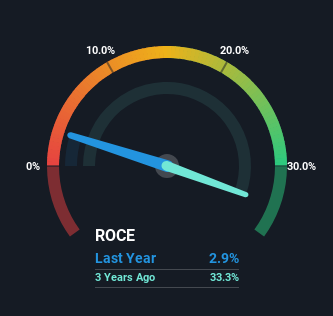- China
- /
- Professional Services
- /
- SZSE:301091
Some Investors May Be Worried About Shenzhen Urban Transport Planning Center's (SZSE:301091) Returns On Capital

If you're looking for a multi-bagger, there's a few things to keep an eye out for. Ideally, a business will show two trends; firstly a growing return on capital employed (ROCE) and secondly, an increasing amount of capital employed. Put simply, these types of businesses are compounding machines, meaning they are continually reinvesting their earnings at ever-higher rates of return. Although, when we looked at Shenzhen Urban Transport Planning Center (SZSE:301091), it didn't seem to tick all of these boxes.
What Is Return On Capital Employed (ROCE)?
For those that aren't sure what ROCE is, it measures the amount of pre-tax profits a company can generate from the capital employed in its business. Analysts use this formula to calculate it for Shenzhen Urban Transport Planning Center:
Return on Capital Employed = Earnings Before Interest and Tax (EBIT) ÷ (Total Assets - Current Liabilities)
0.029 = CN¥68m ÷ (CN¥3.0b - CN¥688m) (Based on the trailing twelve months to September 2023).
So, Shenzhen Urban Transport Planning Center has an ROCE of 2.9%. Ultimately, that's a low return and it under-performs the Professional Services industry average of 5.6%.
Check out our latest analysis for Shenzhen Urban Transport Planning Center

In the above chart we have measured Shenzhen Urban Transport Planning Center's prior ROCE against its prior performance, but the future is arguably more important. If you're interested, you can view the analysts predictions in our free analyst report for Shenzhen Urban Transport Planning Center .
What Can We Tell From Shenzhen Urban Transport Planning Center's ROCE Trend?
In terms of Shenzhen Urban Transport Planning Center's historical ROCE movements, the trend isn't fantastic. Over the last five years, returns on capital have decreased to 2.9% from 22% five years ago. Although, given both revenue and the amount of assets employed in the business have increased, it could suggest the company is investing in growth, and the extra capital has led to a short-term reduction in ROCE. If these investments prove successful, this can bode very well for long term stock performance.
On a side note, Shenzhen Urban Transport Planning Center has done well to pay down its current liabilities to 23% of total assets. That could partly explain why the ROCE has dropped. Effectively this means their suppliers or short-term creditors are funding less of the business, which reduces some elements of risk. Some would claim this reduces the business' efficiency at generating ROCE since it is now funding more of the operations with its own money.
The Bottom Line On Shenzhen Urban Transport Planning Center's ROCE
While returns have fallen for Shenzhen Urban Transport Planning Center in recent times, we're encouraged to see that sales are growing and that the business is reinvesting in its operations. Furthermore the stock has climbed 18% over the last year, it would appear that investors are upbeat about the future. So should these growth trends continue, we'd be optimistic on the stock going forward.
Shenzhen Urban Transport Planning Center does have some risks, we noticed 2 warning signs (and 1 which doesn't sit too well with us) we think you should know about.
If you want to search for solid companies with great earnings, check out this free list of companies with good balance sheets and impressive returns on equity.
New: Manage All Your Stock Portfolios in One Place
We've created the ultimate portfolio companion for stock investors, and it's free.
• Connect an unlimited number of Portfolios and see your total in one currency
• Be alerted to new Warning Signs or Risks via email or mobile
• Track the Fair Value of your stocks
Have feedback on this article? Concerned about the content? Get in touch with us directly. Alternatively, email editorial-team (at) simplywallst.com.
This article by Simply Wall St is general in nature. We provide commentary based on historical data and analyst forecasts only using an unbiased methodology and our articles are not intended to be financial advice. It does not constitute a recommendation to buy or sell any stock, and does not take account of your objectives, or your financial situation. We aim to bring you long-term focused analysis driven by fundamental data. Note that our analysis may not factor in the latest price-sensitive company announcements or qualitative material. Simply Wall St has no position in any stocks mentioned.
About SZSE:301091
Shenzhen Urban Transport Planning Center
Shenzhen Urban Transport Planning Center Co., Ltd.
Excellent balance sheet with reasonable growth potential.
Market Insights
Community Narratives




